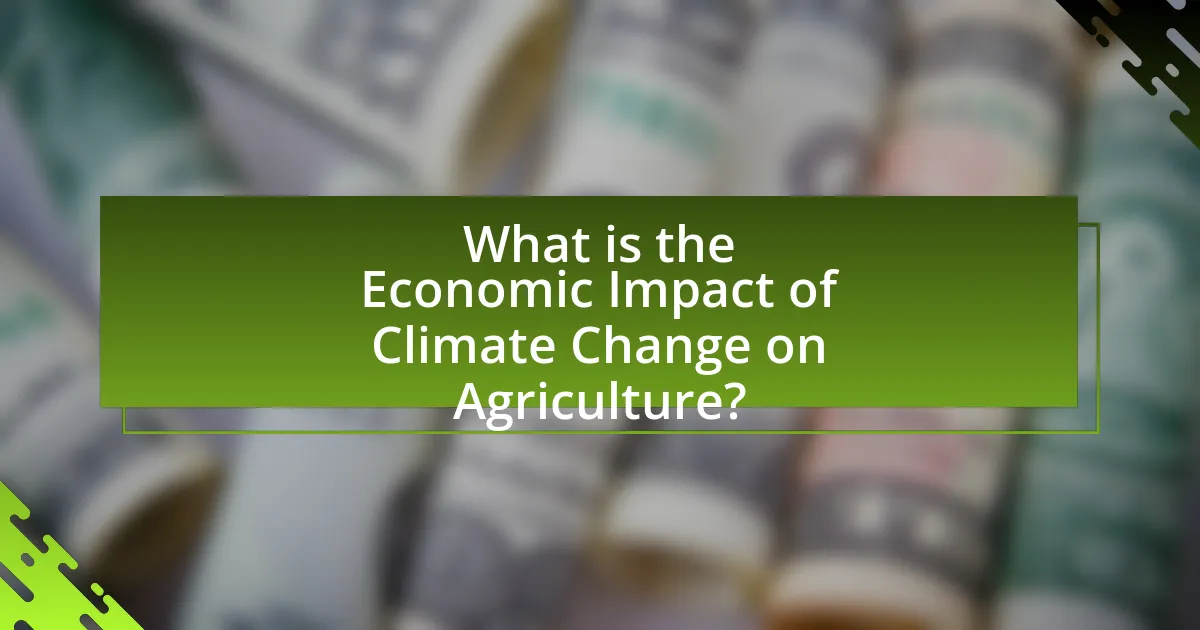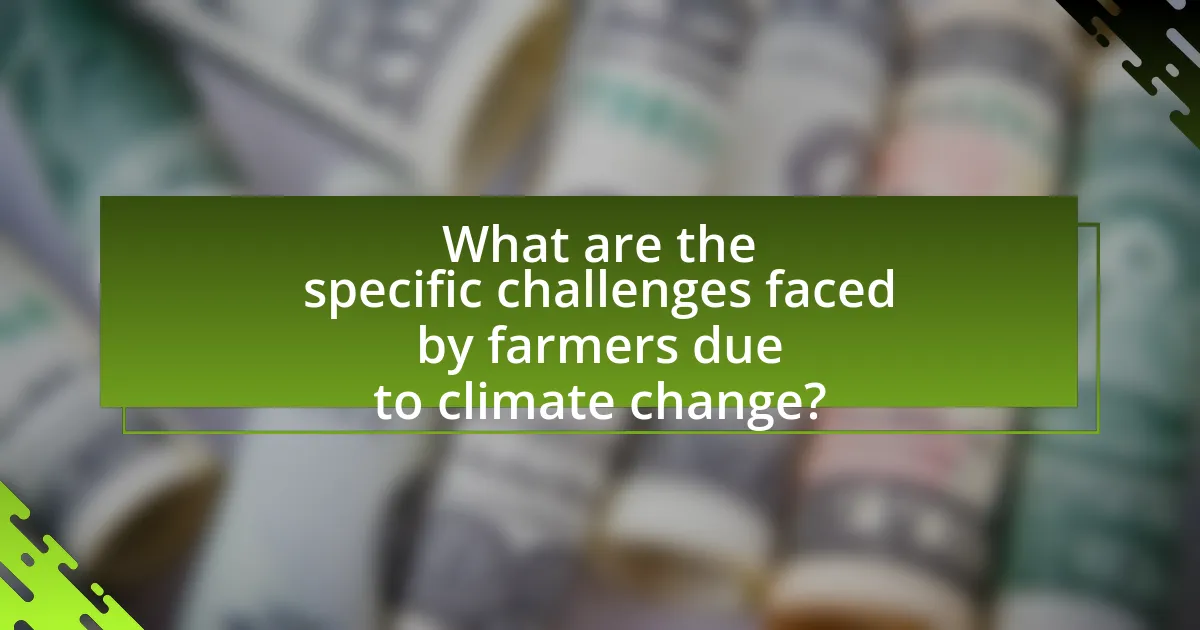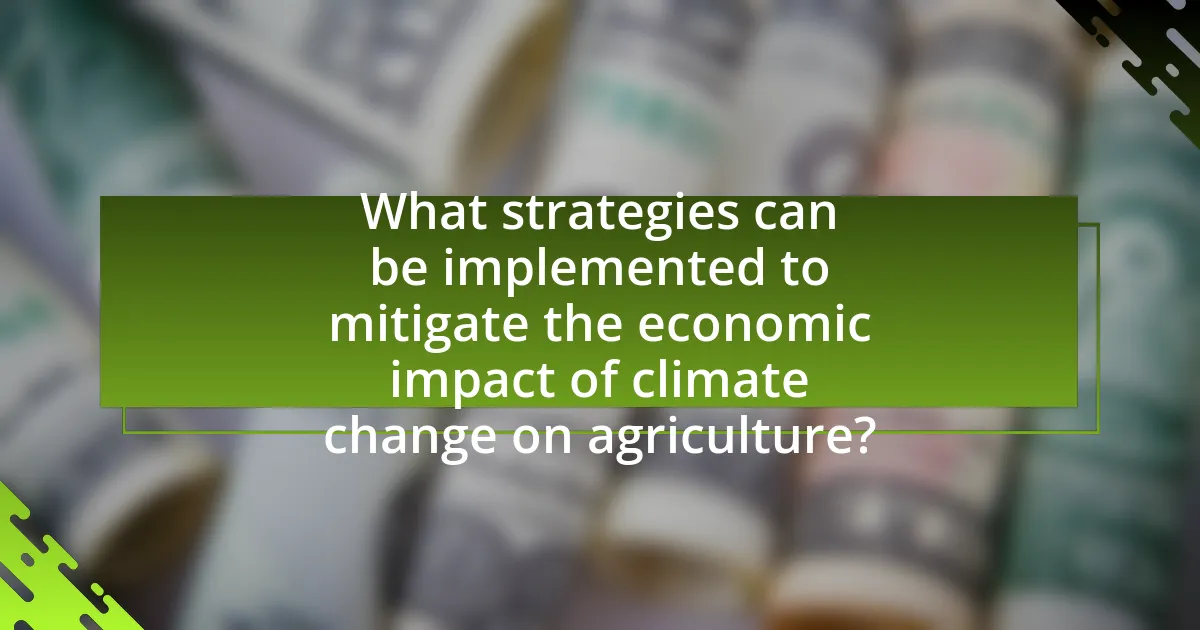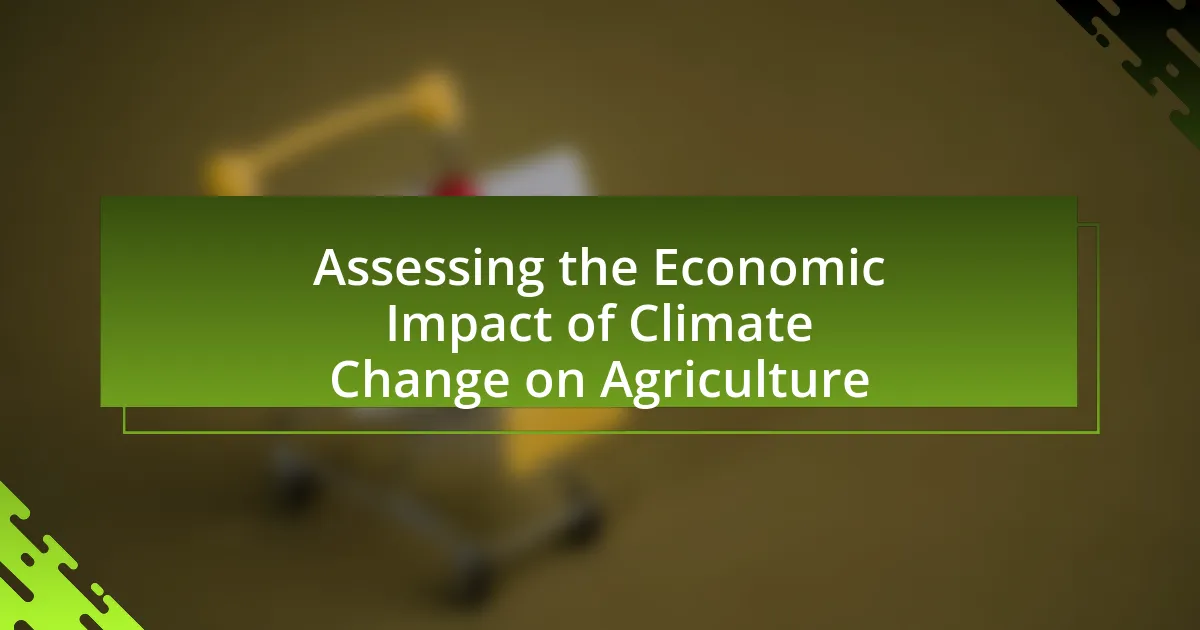The article examines the economic impact of climate change on agriculture, highlighting significant reductions in crop yields and increased production costs. It discusses how altered precipitation patterns, rising temperatures, and extreme weather events threaten global agricultural productivity, potentially decreasing it by up to 30% by 2050. Key factors influencing crop yields, such as temperature, humidity, and sunlight, are analyzed, along with the economic consequences of reduced agricultural output, including increased food prices and decreased farmer incomes. The article also explores strategies for adaptation, the role of government policies, and the importance of research and development in enhancing agricultural resilience against climate change.

What is the Economic Impact of Climate Change on Agriculture?
The economic impact of climate change on agriculture is significant, leading to reduced crop yields and increased production costs. Studies indicate that climate change can decrease global agricultural productivity by up to 30% by 2050, primarily due to altered precipitation patterns, increased temperatures, and the frequency of extreme weather events. For instance, the Intergovernmental Panel on Climate Change (IPCC) reports that rising temperatures can negatively affect staple crops like wheat and maize, resulting in economic losses estimated at $1.3 trillion annually by 2030. Additionally, farmers face higher costs for irrigation and pest control as climate conditions shift, further straining agricultural profitability.
How does climate change affect agricultural productivity?
Climate change negatively affects agricultural productivity by altering temperature and precipitation patterns, which can lead to reduced crop yields. For instance, a study published in the journal “Nature Climate Change” indicates that global crop yields for staples like wheat and maize could decline by up to 25% by 2050 due to rising temperatures and changing rainfall patterns. Additionally, increased frequency of extreme weather events, such as droughts and floods, further disrupts farming practices and reduces the reliability of food supply. These changes threaten food security and economic stability in agricultural sectors worldwide.
What specific climatic factors influence crop yields?
Specific climatic factors that influence crop yields include temperature, precipitation, humidity, and sunlight. Temperature affects plant growth rates and development; for instance, optimal temperatures for many crops range between 20°C to 30°C, while extreme temperatures can lead to reduced yields. Precipitation is crucial for water availability; studies show that a 10% decrease in rainfall can lead to a 20% reduction in crop yields. Humidity impacts transpiration rates and disease prevalence; high humidity can promote fungal diseases, adversely affecting yields. Sunlight is essential for photosynthesis; crops require a minimum of 6-8 hours of sunlight daily for optimal growth. These factors collectively determine the productivity and viability of agricultural systems.
How do changing weather patterns impact farming practices?
Changing weather patterns significantly impact farming practices by altering crop yields, planting schedules, and pest management strategies. For instance, increased temperatures and unpredictable rainfall can lead to reduced agricultural productivity, as evidenced by a study from the Intergovernmental Panel on Climate Change, which indicates that global crop yields could decline by up to 25% by 2050 due to climate change. Farmers may need to adapt by shifting to more resilient crop varieties, adjusting planting dates, and implementing advanced irrigation techniques to cope with these changes. Additionally, the frequency of extreme weather events, such as droughts and floods, necessitates a reevaluation of traditional farming methods to ensure sustainability and economic viability.
What are the economic consequences of reduced agricultural output?
Reduced agricultural output leads to increased food prices, decreased farmer incomes, and heightened food insecurity. When agricultural production declines, supply diminishes, causing prices to rise due to the basic economic principle of supply and demand. For instance, the Food and Agriculture Organization reported that a 10% reduction in crop yields can lead to a 20% increase in food prices. This price surge negatively impacts consumers, particularly low-income households, who spend a larger portion of their income on food. Additionally, farmers face reduced revenues, which can lead to lower investments in their operations and potential bankruptcies, further exacerbating economic instability in rural areas. The overall economic consequences include increased inflation, reduced consumer spending, and potential job losses in agriculture-related sectors.
How does decreased crop yield affect farmers’ income?
Decreased crop yield directly reduces farmers’ income by lowering the quantity of produce available for sale. When crop yields decline, farmers face diminished revenue from their harvests, which can lead to financial instability. For instance, a study by the Food and Agriculture Organization (FAO) indicates that a 10% decrease in crop yield can result in a corresponding 10% drop in income for farmers, particularly in regions heavily reliant on agriculture. This financial strain can affect farmers’ ability to invest in future crops, pay off debts, and sustain their livelihoods, ultimately impacting the broader agricultural economy.
What are the broader economic implications for rural communities?
The broader economic implications for rural communities include increased vulnerability to climate change, which can lead to reduced agricultural productivity and income instability. As climate change affects weather patterns, rural areas that rely heavily on agriculture may experience crop failures, leading to economic downturns. For instance, the National Oceanic and Atmospheric Administration reported that extreme weather events have increased in frequency, impacting farming yields and consequently the livelihoods of rural populations. Additionally, rural communities may face challenges in accessing resources and markets, further exacerbating economic disparities. This situation can lead to population decline as individuals migrate to urban areas in search of better opportunities, thereby diminishing the economic base of these communities.
Why is it important to assess the economic impact of climate change on agriculture?
Assessing the economic impact of climate change on agriculture is crucial because it informs policymakers and stakeholders about potential risks and opportunities within the agricultural sector. Understanding these impacts allows for the development of strategies to mitigate adverse effects, such as reduced crop yields and increased production costs, which can threaten food security. For instance, a study by the Intergovernmental Panel on Climate Change (IPCC) indicates that climate change could reduce global agricultural productivity by up to 30% by 2050 if no adaptive measures are taken. This data underscores the necessity of economic assessments to guide investments in resilient agricultural practices and technologies.
How can understanding these impacts inform policy decisions?
Understanding the economic impacts of climate change on agriculture can significantly inform policy decisions by providing data-driven insights that guide resource allocation and regulatory frameworks. For instance, recognizing that climate change can reduce crop yields by up to 30% in certain regions allows policymakers to prioritize investments in climate-resilient agricultural practices and technologies. Additionally, studies indicate that adapting agricultural policies to mitigate these impacts can enhance food security and stabilize rural economies, as evidenced by the Food and Agriculture Organization’s report highlighting the need for adaptive measures in vulnerable regions. Thus, informed policy decisions can lead to more sustainable agricultural systems that are better equipped to handle the challenges posed by climate change.
What role does agriculture play in national economies?
Agriculture plays a crucial role in national economies by contributing to food security, employment, and economic growth. It is a primary source of livelihood for a significant portion of the population, particularly in developing countries, where it accounts for about 30% of GDP and employs over 60% of the workforce. Furthermore, agriculture drives rural development and supports related industries such as food processing and distribution. The sector also influences trade balances, as many countries rely on agricultural exports to generate foreign exchange. For instance, in 2020, global agricultural exports were valued at approximately $1.5 trillion, highlighting agriculture’s importance in international trade and economic stability.

What are the specific challenges faced by farmers due to climate change?
Farmers face specific challenges due to climate change, including increased frequency of extreme weather events, shifting growing seasons, and reduced crop yields. Extreme weather, such as droughts and floods, disrupts planting and harvesting schedules, leading to financial losses. Shifting growing seasons affect the timing of planting and harvesting, which can result in mismatches with market demand. Additionally, rising temperatures and changing precipitation patterns can lead to decreased crop productivity; for instance, studies indicate that wheat yields could decline by up to 6% for every degree Celsius increase in temperature. These challenges collectively threaten food security and the economic viability of farming operations.
How do extreme weather events affect agricultural operations?
Extreme weather events significantly disrupt agricultural operations by causing crop damage, soil erosion, and reduced yields. For instance, droughts can lead to water scarcity, affecting irrigation and crop growth, while heavy rainfall can result in flooding, which damages crops and erodes soil. According to the Intergovernmental Panel on Climate Change (IPCC), extreme weather events are projected to increase in frequency and intensity, further threatening food security and agricultural productivity. In the United States, the National Oceanic and Atmospheric Administration (NOAA) reported that severe weather events caused agricultural losses exceeding $1 billion annually over the past decade. These impacts highlight the vulnerability of agricultural systems to climate variability and underscore the need for adaptive strategies to mitigate these risks.
What types of extreme weather are most damaging to crops?
Extreme weather types that are most damaging to crops include droughts, floods, hurricanes, and extreme temperatures. Droughts lead to water scarcity, which can severely reduce crop yields; for instance, the 2012 U.S. drought resulted in a 13% decrease in corn production. Floods can cause soil erosion and waterlogging, negatively impacting root systems and crop health, as seen in the 2010 Pakistan floods that devastated millions of acres of farmland. Hurricanes bring strong winds and heavy rainfall, which can destroy crops and infrastructure, exemplified by Hurricane Harvey in 2017, which caused significant agricultural losses in Texas. Lastly, extreme temperatures, both high and low, can stress plants and disrupt growth cycles, with studies indicating that a 1°C increase in temperature can reduce wheat yields by up to 6%.
How can farmers prepare for and mitigate these risks?
Farmers can prepare for and mitigate risks associated with climate change by adopting sustainable agricultural practices, diversifying crops, and utilizing technology for better resource management. Sustainable practices, such as crop rotation and conservation tillage, enhance soil health and resilience against extreme weather events. Diversifying crops reduces dependency on a single crop, thereby minimizing financial risk if one crop fails due to climate impacts. Additionally, technology, including precision agriculture tools and climate forecasting, allows farmers to make informed decisions about planting and resource allocation, ultimately improving yield and reducing losses. Studies indicate that these strategies can lead to increased productivity and economic stability, demonstrating their effectiveness in addressing climate-related risks in agriculture.
What are the financial implications of climate-related crop failures?
Climate-related crop failures lead to significant financial implications, including reduced agricultural income, increased food prices, and economic instability for farming communities. For instance, the U.S. Department of Agriculture reported that droughts can cause crop yield losses of up to 50%, directly impacting farmers’ revenues and leading to increased reliance on government subsidies. Additionally, the Food and Agriculture Organization noted that global food prices can rise by 10% to 20% following major crop failures, affecting consumers and exacerbating food insecurity. These financial strains can also ripple through local economies, resulting in job losses and decreased spending in agricultural regions.
How do insurance and financial support systems respond to climate impacts?
Insurance and financial support systems respond to climate impacts by providing risk management tools and financial assistance to mitigate losses. These systems, such as crop insurance and disaster relief funds, are designed to protect farmers from the financial repercussions of climate-related events like droughts, floods, and storms. For instance, the Federal Crop Insurance program in the United States covers a significant portion of farmers’ losses, with payouts reaching approximately $7 billion annually in response to climate-related disasters. Additionally, financial support mechanisms, including grants and low-interest loans, help farmers invest in climate-resilient practices, thereby enhancing their adaptive capacity. These responses are crucial for sustaining agricultural productivity and economic stability in the face of increasing climate variability.
What are the long-term economic effects of repeated crop failures?
Repeated crop failures lead to significant long-term economic effects, including reduced agricultural productivity, increased food prices, and heightened rural poverty. Over time, persistent failures diminish farmers’ income, leading to decreased investment in agricultural technology and practices, which further exacerbates productivity issues. For instance, the Food and Agriculture Organization reported that in regions experiencing recurrent droughts, crop yields can decline by up to 50%, severely impacting local economies reliant on agriculture. Additionally, food scarcity resulting from these failures can drive up prices, contributing to inflation and making food less accessible for low-income populations. This cycle can perpetuate poverty, as families may deplete savings or incur debt to cope with food shortages, ultimately leading to long-term economic instability in affected regions.
How does climate change affect agricultural labor?
Climate change significantly affects agricultural labor by altering weather patterns, which impacts crop yields and labor demand. For instance, increased temperatures and unpredictable rainfall can lead to reduced agricultural productivity, forcing laborers to adapt to changing planting and harvesting schedules. According to the Intergovernmental Panel on Climate Change (IPCC), climate change could reduce global agricultural productivity by up to 25% by 2050, directly influencing the availability and stability of agricultural jobs. Additionally, extreme weather events, such as droughts and floods, can lead to labor shortages as workers may be unable to perform their duties or may migrate to other regions in search of stable employment.
What are the implications for labor availability and costs?
Climate change significantly impacts labor availability and costs in agriculture. As extreme weather events and shifting climate patterns disrupt traditional farming practices, labor shortages may arise due to increased difficulty in working conditions and the need for specialized skills in adapting to new agricultural technologies. For instance, a study by the National Oceanic and Atmospheric Administration (NOAA) indicates that rising temperatures and unpredictable weather can lead to reduced crop yields, prompting farmers to require more labor during peak seasons to manage the increased workload. Consequently, this demand can drive up labor costs, as employers may need to offer higher wages to attract workers in a competitive market. Additionally, labor availability may be further strained by migration patterns influenced by climate change, as workers relocate from affected areas, exacerbating labor shortages in regions still reliant on agriculture.
How does climate change influence labor productivity in agriculture?
Climate change negatively influences labor productivity in agriculture by altering weather patterns, increasing temperatures, and affecting crop yields. For instance, rising temperatures can lead to heat stress in both crops and agricultural workers, reducing efficiency and output. A study by the International Food Policy Research Institute found that climate change could decrease agricultural productivity by up to 30% in some regions by 2050, primarily due to increased heat and changing precipitation patterns. Additionally, extreme weather events, such as droughts and floods, disrupt planting and harvesting schedules, further diminishing labor productivity.

What strategies can be implemented to mitigate the economic impact of climate change on agriculture?
To mitigate the economic impact of climate change on agriculture, farmers can adopt sustainable practices such as crop diversification, precision agriculture, and improved water management. Crop diversification reduces the risk of total crop failure due to climate variability, as different crops may respond differently to changing conditions. Precision agriculture utilizes technology to optimize field-level management regarding crop farming, which can enhance productivity and reduce waste. Improved water management techniques, such as rainwater harvesting and drip irrigation, can help conserve water resources and ensure crops receive adequate moisture even during droughts. According to a report by the Food and Agriculture Organization, implementing these strategies can lead to increased resilience and economic stability for farmers facing climate-related challenges.
How can farmers adapt their practices to changing climatic conditions?
Farmers can adapt their practices to changing climatic conditions by implementing sustainable agricultural techniques, such as crop rotation, conservation tillage, and integrated pest management. These methods enhance soil health, improve water retention, and reduce dependency on chemical inputs, which are crucial as climate variability increases. For instance, a study by the Food and Agriculture Organization (FAO) indicates that crop rotation can increase yields by 20-30% under changing climate scenarios, demonstrating its effectiveness in maintaining productivity. Additionally, adopting drought-resistant crop varieties can help mitigate the impacts of reduced rainfall, as evidenced by research from the International Food Policy Research Institute, which shows that such varieties can increase resilience and yield stability in arid regions.
What innovative agricultural techniques can enhance resilience?
Innovative agricultural techniques that can enhance resilience include agroecology, precision agriculture, and the use of drought-resistant crop varieties. Agroecology promotes biodiversity and sustainable practices, which can improve soil health and ecosystem services, thereby increasing resilience to climate impacts. Precision agriculture utilizes technology such as GPS and sensors to optimize resource use, reducing waste and enhancing productivity under varying climatic conditions. Drought-resistant crop varieties are specifically bred to withstand water scarcity, ensuring food security even in adverse weather scenarios. These techniques have been shown to improve yield stability and reduce vulnerability to climate change, as evidenced by studies indicating that agroecological practices can increase yields by 20-50% in degraded environments.
How can crop diversification reduce economic risks?
Crop diversification can reduce economic risks by spreading financial exposure across multiple crops, thereby minimizing the impact of market fluctuations and climate-related failures. When farmers cultivate a variety of crops, they are less vulnerable to the total loss of income from a single crop due to pests, diseases, or adverse weather conditions. For instance, a study by the Food and Agriculture Organization (FAO) indicates that diversified farming systems can enhance resilience to climate change, as different crops may respond variably to environmental stresses. This approach not only stabilizes income but also improves soil health and biodiversity, further supporting sustainable agricultural practices.
What role do government policies play in supporting agricultural adaptation?
Government policies play a crucial role in supporting agricultural adaptation by providing financial incentives, research funding, and regulatory frameworks that facilitate the adoption of sustainable practices. These policies can include subsidies for climate-resilient crops, investment in agricultural research and development, and the establishment of insurance programs that protect farmers against climate-related losses. For instance, the U.S. Department of Agriculture’s (USDA) Climate Hubs offer resources and tools to help farmers adapt to changing climate conditions, demonstrating the effectiveness of targeted government initiatives in enhancing agricultural resilience.
What types of subsidies or incentives can promote sustainable practices?
Financial subsidies and incentives that promote sustainable practices include direct payments for conservation, tax credits for renewable energy investments, and grants for sustainable agricultural practices. Direct payments for conservation, such as those provided through programs like the Conservation Reserve Program in the United States, incentivize landowners to adopt environmentally friendly practices by compensating them for not converting sensitive land to agricultural use. Tax credits for renewable energy investments encourage businesses and individuals to invest in solar, wind, and other renewable energy sources, thereby reducing reliance on fossil fuels. Grants for sustainable agricultural practices, such as those offered by the Environmental Quality Incentives Program, support farmers in implementing practices that enhance soil health, reduce water usage, and lower greenhouse gas emissions. These financial mechanisms have been shown to effectively drive the adoption of sustainable practices, as evidenced by increased participation in conservation programs and a rise in renewable energy installations.
How can research and development contribute to agricultural resilience?
Research and development can significantly enhance agricultural resilience by fostering innovation in crop varieties, farming practices, and resource management. For instance, the development of drought-resistant crops through genetic engineering allows farmers to maintain yields despite adverse climate conditions, thereby reducing economic losses. A study by the International Food Policy Research Institute found that improved crop varieties can increase yields by up to 30% in drought-prone areas. Additionally, R&D in precision agriculture technologies enables farmers to optimize resource use, minimizing waste and enhancing productivity. This approach not only supports sustainable farming but also helps mitigate the economic impacts of climate change on agriculture.
What best practices can farmers adopt to minimize economic losses?
Farmers can minimize economic losses by adopting precision agriculture techniques, which optimize resource use and enhance crop yields. Precision agriculture utilizes technology such as GPS and data analytics to monitor field variability, allowing farmers to apply water, fertilizers, and pesticides more efficiently. Research indicates that implementing precision agriculture can increase crop yields by 10-20% while reducing input costs by 15-30%, leading to significant economic benefits. Additionally, diversifying crops and implementing sustainable practices, such as crop rotation and cover cropping, can improve soil health and resilience against climate variability, further safeguarding farmers’ economic interests.
How can technology improve efficiency and reduce vulnerability?
Technology can improve efficiency and reduce vulnerability in agriculture by enabling precision farming techniques. These techniques utilize data analytics, sensors, and automation to optimize resource use, such as water and fertilizers, leading to increased crop yields and reduced waste. For instance, a study by the Food and Agriculture Organization (FAO) indicates that precision agriculture can increase productivity by up to 20% while minimizing environmental impact. Additionally, technology such as climate-resilient crop varieties and advanced weather forecasting tools helps farmers adapt to changing climate conditions, thereby reducing their vulnerability to climate-related risks.
What are the key considerations for sustainable farming in a changing climate?
Key considerations for sustainable farming in a changing climate include soil health, water management, crop diversity, and adaptive practices. Soil health is crucial as it enhances resilience against climate variability; practices such as cover cropping and reduced tillage improve soil structure and fertility. Effective water management, including rainwater harvesting and efficient irrigation systems, helps mitigate drought impacts and ensures crop viability. Crop diversity, through the cultivation of various species, reduces vulnerability to pests and diseases while enhancing ecosystem stability. Adaptive practices, such as shifting planting dates and selecting climate-resilient crop varieties, enable farmers to respond effectively to changing climatic conditions. These considerations are supported by research indicating that sustainable practices can increase agricultural productivity and economic stability in the face of climate change.



